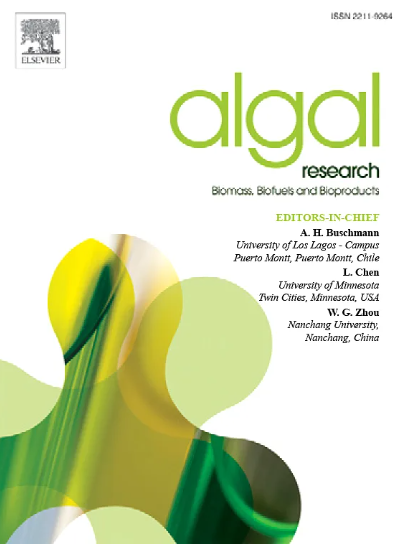Profiling and antiproliferative activity of tropical seaweed extracts using LC-HRMS and in silico approaches
IF 4.5
2区 生物学
Q1 BIOTECHNOLOGY & APPLIED MICROBIOLOGY
Algal Research-Biomass Biofuels and Bioproducts
Pub Date : 2025-07-02
DOI:10.1016/j.algal.2025.104181
引用次数: 0
Abstract
Seaweeds offer significant potential at the intersection of functional food development and drug discovery, as they can be safely incorporated into the human diet and exhibit antiproliferative activity against cancer cell lines. This study aims to investigate the metabolite profile of water extracts from seaweed and evaluate their antiproliferative properties. The methodology employed in this study encompassed six key steps: extraction, LC-HRMS-based metabolite identification, antiproliferative assays, correlation analysis using partial least squares regression (PLSR), molecular docking, and molecular dynamics (MD) simulations. Metabolites were extracted from three seaweed species via maceration using deionized water, followed by profiling through liquid chromatography–high-resolution mass spectrometry (LC-HRMS). Among the extracts, Sargassum cinereum demonstrated the most potent antiproliferative activity, with an IC₅₀ value of 46.89 μg/mL as determined by the MTT assay. PLSR analysis identified meconic acid as a key predictor of cell viability. In the in silico analysis, docking scores obtained from AutoDock Vina were re-ranked using the XGBoost machine learning algorithm. The top-ranked compounds based on binding affinity to the target protein (PDB ID: 7KP8) were (3β,22E,24S)-3-Hydroxyergosta-5,8,22-trien-7-one from Ulva lactuca (−10.02 kcal/mol), 2,3,5,6,8-pentahydroxy-1,4-naphthalenedione from S. cinereum (−8.40 kcal/mol), and 5,2′,5′-trihydroxy-3,7,8-trimethoxyflavone 2′-acetate from Turbinaria decurrens (−8.80 kcal/mol). Molecular dynamics simulations over 100 ns confirmed the stability of these ligand–protein complexes. These findings indicate that metabolites derived from U. lactuca, S. cinereum, and T. decurrens possess promising potential compounds with inhibitory activity against lung cancer progression.
利用LC-HRMS和计算机方法分析热带海藻提取物及其抗增殖活性
海藻在功能食品开发和药物发现的交叉点上提供了巨大的潜力,因为它们可以安全地纳入人类饮食中,并表现出对癌细胞系的抗增殖活性。本研究旨在研究海藻水提物的代谢谱,并评价其抗增殖特性。本研究采用的方法包括六个关键步骤:提取、基于lc - hrms的代谢物鉴定、抗增殖试验、使用偏最小二乘回归(PLSR)的相关性分析、分子对接和分子动力学(MD)模拟。采用去离子水浸渍法提取3种海藻的代谢物,并采用液相色谱-高分辨率质谱法(LC-HRMS)进行分析。在提取物中,马尾草显示出最有效的抗增殖活性,通过MTT试验确定IC₅0值为46.89 μg/mL。PLSR分析发现,meconic acid是细胞活力的关键预测因子。在计算机分析中,使用XGBoost机器学习算法对AutoDock Vina获得的对接分数进行重新排序。根据与目标蛋白的结合亲和力(PDB ID: 7KP8),排名前三位的化合物是来自Ulva lactuca的(3β,22E,24S)-3- hydroxyergosta -5,8,22-trien-7-one (- 10.02 kcal/mol),来自S. cinereum的2,3,5,6,8- penta羟基-1,4-naphthalenedione (- 8.40 kcal/mol),以及来自Turbinaria decurrens的5,2 ',5 ' -三羟基-3,7,8- tri甲氧基黄酮2 ' -acetate (- 8.80 kcal/mol)。100 ns以上的分子动力学模拟证实了这些配体-蛋白复合物的稳定性。这些发现表明,乳葡菌、电影院葡萄球菌和潜行葡萄球菌的代谢物具有抑制肺癌进展的潜在化合物。
本文章由计算机程序翻译,如有差异,请以英文原文为准。
求助全文
约1分钟内获得全文
求助全文
来源期刊

Algal Research-Biomass Biofuels and Bioproducts
BIOTECHNOLOGY & APPLIED MICROBIOLOGY-
CiteScore
9.40
自引率
7.80%
发文量
332
期刊介绍:
Algal Research is an international phycology journal covering all areas of emerging technologies in algae biology, biomass production, cultivation, harvesting, extraction, bioproducts, biorefinery, engineering, and econometrics. Algae is defined to include cyanobacteria, microalgae, and protists and symbionts of interest in biotechnology. The journal publishes original research and reviews for the following scope: algal biology, including but not exclusive to: phylogeny, biodiversity, molecular traits, metabolic regulation, and genetic engineering, algal cultivation, e.g. phototrophic systems, heterotrophic systems, and mixotrophic systems, algal harvesting and extraction systems, biotechnology to convert algal biomass and components into biofuels and bioproducts, e.g., nutraceuticals, pharmaceuticals, animal feed, plastics, etc. algal products and their economic assessment
 求助内容:
求助内容: 应助结果提醒方式:
应助结果提醒方式:


